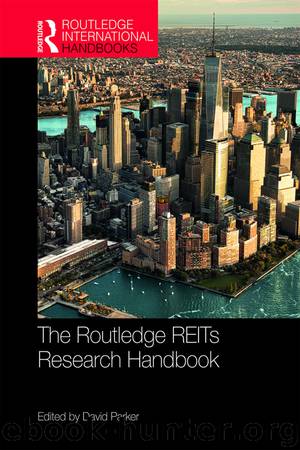The Routledge REITs Research Handbook by Parker David;

Author:Parker, David;
Language: eng
Format: epub
Publisher: Routledge
Published: 2018-09-20T00:00:00+00:00
The answer to the first question seems to be that REITs are real estate, albeit in the long run. So long-run investors should expect total returns approximating those achieved from the private real estate market. Indeed, since the performance of REITs is ultimately dependent upon the performance of the underlying property, a close link between markets is to be expected. It should be noted that “long-term” in this context may be at least five years, which would seem to negate the liquidity advantage of REITs. Nonetheless, REITs can provide some of the diversification opportunities of private real estate not normally available to smaller investors, plus new investment opportunities with the added bonus of liquidity. However, these advantages come at increased volatility and loss of control.
The answer to the second question, what place, if any, do REITs have in the mixed-asset portfolio, is more problematical as previous research and the results of the empirical test herein are mixed such that no clear recommendation for adding REITs to a mixed-asset portfolio can be given. On the one hand, the results suggest that the inclusion of REITs into a portfolio of stocks and bonds over the long-run increases risk-adjusted performance, due to the return enhancement of REITs. So for those investors with an appetite for more return REITs may be an attractive addition to their mixed-asset portfolio, if they are willing to accept greater volatility. The enhanced performance from including REITs in the mixed-asset portfolio however can be traced to just two time periods when REITs performed exceptionally well, being the Modern REIT Era and when REITs moved from “Main Street to Wall Street”. Therefore, deciding if REITs will offer such exceptional performance in the future is a real challenge for investors.
Nonetheless, there are a number of characteristics of REITs that provide clues to investors when considering including REITs in their mixed-asset portfolio. First, since in the long-run REITs tend to behave more like private real estate, even allowing for the presence of a stock market component, REITs will perform well when private real estate performs well and vice versa. Second, due to their use of leverage, REITs they will perform badly in times of financial distress and vice versa. Third, as REIT returns are more correlated with small cap stocks, especially small cap value stocks, rather than the stock market as a whole because of the typically small market capitalization of REIT issues, they will perform relatively well when value stocks perform well and vice versa. These pointers as to when REITs are likely to perform well can be incorporated into an asset allocation framework and provide the potential to generate increased returns. Therefore, how good investors are in identifying these capital market regimes will determine the performance of their portfolios.
This chapter concludes Part I of this book with Part II including six chapters each analysing REITs in a region of the world, using case studies from a developed, developing and emerging REIT sector in the region, concluding with Chapter 14 which considers Directions for the Future of International REITs.
Download
This site does not store any files on its server. We only index and link to content provided by other sites. Please contact the content providers to delete copyright contents if any and email us, we'll remove relevant links or contents immediately.
The Body: A Guide for Occupants by Bill Bryson(4974)
Audition by Ryu Murakami(4850)
Adulting by Kelly Williams Brown(4487)
Housekeeping by Marilynne Robinson(4347)
Be in a Treehouse by Pete Nelson(3947)
Zero Waste Home by Bea Johnson(3777)
Seriously... I'm Kidding by Ellen DeGeneres(3577)
Better Homes and Gardens New Cookbook by Better Homes & Gardens(3525)
The Healing Self by Deepak Chopra(3474)
Barkskins by Annie Proulx(3313)
Hedgerow by John Wright(3276)
The Cellar by Natasha Preston(3261)
Spark Joy by Marie Kondo(3249)
The Genius of Japanese Carpentry by Azby Brown(3224)
The Life-Changing Magic Of Tidying Up- The Japanese Art Of Decluttering And Organizing (v5.0) by Marie Kondo(3211)
120 Days of Sodom by Marquis de Sade(3180)
Work Clean by Dan Charnas(3048)
The Book of Numbers by Peter Bentley(2912)
A Monk's Guide to a Clean House and Mind by Shoukei Matsumoto(2868)
